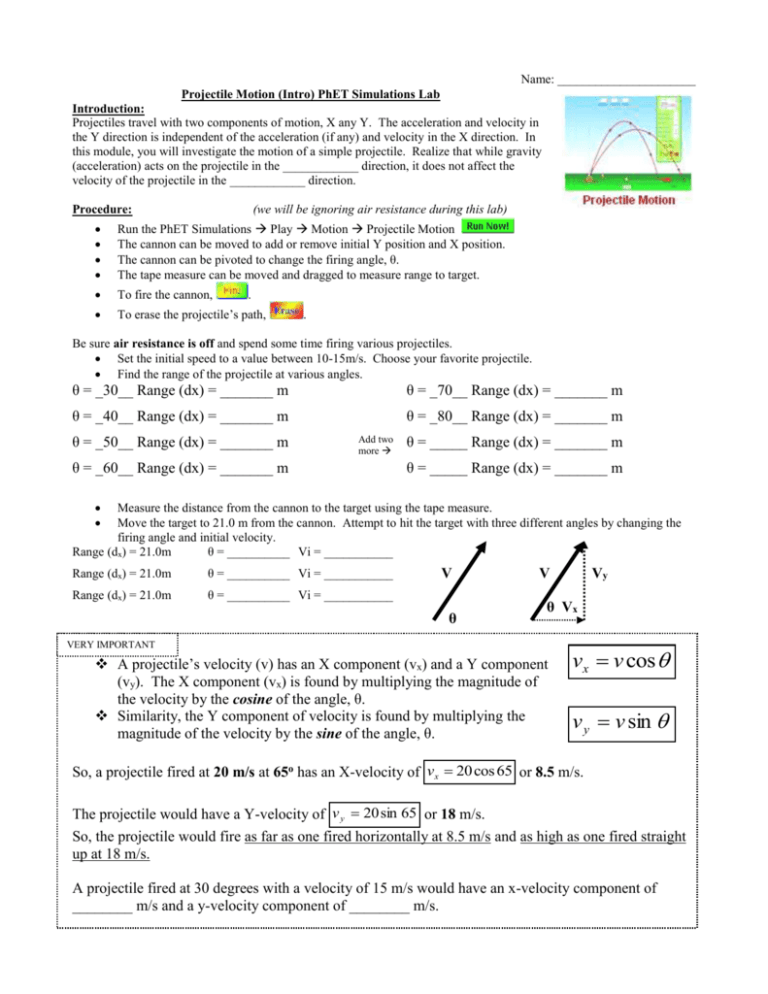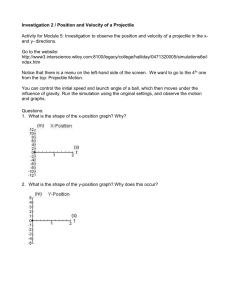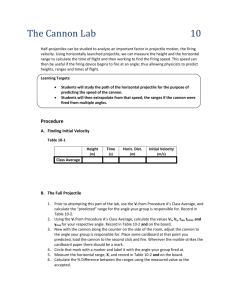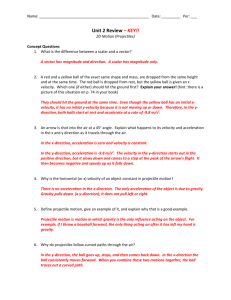Projectiles PhET Lab
advertisement

Name: ______________________ Projectile Motion (Intro) PhET Simulations Lab Introduction: Projectiles travel with two components of motion, X any Y. The acceleration and velocity in the Y direction is independent of the acceleration (if any) and velocity in the X direction. In this module, you will investigate the motion of a simple projectile. Realize that while gravity (acceleration) acts on the projectile in the ____________ direction, it does not affect the velocity of the projectile in the ____________ direction. Procedure: (we will be ignoring air resistance during this lab) Run the PhET Simulations Play Motion Projectile Motion The cannon can be moved to add or remove initial Y position and X position. The cannon can be pivoted to change the firing angle, θ. The tape measure can be moved and dragged to measure range to target. To fire the cannon, To erase the projectile’s path, . . Be sure air resistance is off and spend some time firing various projectiles. Set the initial speed to a value between 10-15m/s. Choose your favorite projectile. Find the range of the projectile at various angles. θ = _30__ Range (dx) = _______ m θ = _70__ Range (dx) = _______ m θ = _40__ Range (dx) = _______ m θ = _80__ Range (dx) = _______ m θ = _50__ Range (dx) = _______ m Add two more θ = _60__ Range (dx) = _______ m θ = _____ Range (dx) = _______ m θ = _____ Range (dx) = _______ m Measure the distance from the cannon to the target using the tape measure. Move the target to 21.0 m from the cannon. Attempt to hit the target with three different angles by changing the firing angle and initial velocity. Range (dx) = 21.0m θ = __________ Vi = ___________ Range (dx) = 21.0m θ = __________ Vi = ___________ Range (dx) = 21.0m θ = __________ Vi = ___________ V θ V Vy θ Vx VERY IMPORTANT A projectile’s velocity (v) has an X component (vx) and a Y component (vy). The X component (vx) is found by multiplying the magnitude of the velocity by the cosine of the angle, θ. Similarity, the Y component of velocity is found by multiplying the magnitude of the velocity by the sine of the angle, θ. vx v cos v y v sin So, a projectile fired at 20 m/s at 65o has an X-velocity of vx 20 cos 65 or 8.5 m/s. The projectile would have a Y-velocity of v y 20 sin 65 or 18 m/s. So, the projectile would fire as far as one fired horizontally at 8.5 m/s and as high as one fired straight up at 18 m/s. A projectile fired at 30 degrees with a velocity of 15 m/s would have an x-velocity component of ________ m/s and a y-velocity component of ________ m/s. Calculate the components of the following projectile’s velocities: 1. v = 35 m/s θ = 15o vx =____ vy = ____ 4. v = 35 m/s θ = 60o vx =_____ vy = ____ 2. v = 35 m/s θ = 30o vx =____ vy = ____ 5. v = 35 m/s θ = 75o vx =_____ vy = ____ 3. v = 35 m/s θ = 45o vx =____ vy = ____ 6. v = 35 m/s θ = 90o vx =_____ vy = ____ We can reverse the process and combine the two components of velocity back into one velocity fired at an angle. The magnitude of velocity is found using the Pythagorean Theorem with vx and vy as the legs of a right triangle. For instance, the velocity of a projectile with an x-component of 7.2 and a y-component of 4.8 is 7.2 2 4.82 8.7 m/s. The angle above the horizontal is found using the inverse tangent (tan-1) of the legs vy/vx. For 4 .8 instance, the angle of the projectile described above would be tan 1 ( ) = 34o. 7 .2 Calculate the velocity magnitude and angle of the projectiles listed below: 7. vx = 5.6 vy = 6.4 v =_____ θ = ______ 9. vx = 8.1 vy = -7.2 v =_____ θ = _____ 8. vx = 2.8 vy = 4.9 v =_____ θ = ______ 10. vx = -1.3 vy = -5.2 v = ____ θ = _____ Conclusion Questions: 1. Without air resistance, the piano travels further / the same distance as the football. (circle) 2. This is due to the fact that velocity in the X-direction increases / is constant / decreases as projectiles travel. 3. The Y-component of velocity increases / is constant / decreases as projectiles travel. 4. The answers to #2 and #3 are due to the fact that gravity acts only in the Y / both the X any Y direction. 5. The path of a projectile is a linear curve / round curve / parabolic curve. 6. This is due to the fact that the time component in the free fall equation (dy) is _____________. 7. Without air resistance, maximum range of a projectile is obtained with an angle of_________ . 8. The same range can be obtained with angles of ________ and ________. 9. Firing a projectile at 25 m/s at an angle of 35o is similar to firing a projectile with a speed of __________________ straight up and __________________ horizontally. 10. A projectile with a horizontal component of 13 m/s and a vertical component of 18 m/s would have an overall velocity of ________________ m/s at an angle of _______________ above the horizontal.









